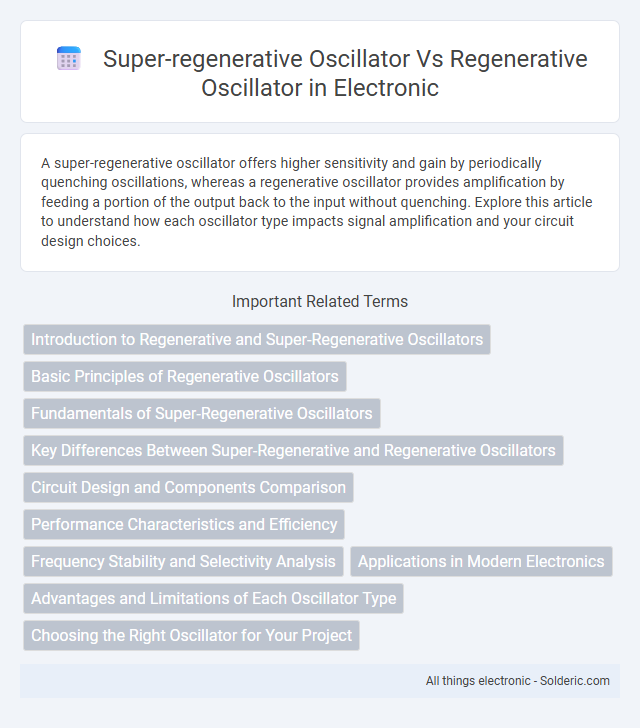A super-regenerative oscillator offers higher sensitivity and gain by periodically quenching oscillations, whereas a regenerative oscillator provides amplification by feeding a portion of the output back to the input without quenching. Explore this article to understand how each oscillator type impacts signal amplification and your circuit design choices.
Comparison Table
| Feature | Super-Regenerative Oscillator | Regenerative Oscillator |
|---|---|---|
| Oscillation Principle | Periodic quenching of oscillations to amplify signals | Continuous feedback for oscillation and signal amplification |
| Signal Amplification | High gain due to quenching technique | Moderate gain through positive feedback |
| Frequency Stability | Lower stability due to quench frequency interference | Higher stability, better frequency control |
| Complexity | More complex circuit design | Simpler design with fewer components |
| Applications | Used in low-cost receivers, short-range communication | Used in radio receivers, amplifiers, tuners |
| Power Consumption | Generally lower due to quenching operation | Higher due to continuous oscillation |
| Noise Performance | Tends to have higher noise due to quench pulses | Lower noise, cleaner signal output |
Introduction to Regenerative and Super-Regenerative Oscillators
Regenerative oscillators use positive feedback to amplify and sustain oscillations at a stable frequency, commonly employed in early radio receivers for signal detection. Super-regenerative oscillators extend this principle by incorporating periodic quenching, allowing them to achieve higher sensitivity and faster response times suited for low-power, wideband applications. Both types leverage feedback loops but differ in complexity and performance characteristics, with super-regenerative designs providing significant improvements in gain and selectivity.
Basic Principles of Regenerative Oscillators
Regenerative oscillators use positive feedback to sustain oscillations at a resonant frequency, relying on a carefully controlled feedback loop to maintain amplitude stability. Super-regenerative oscillators amplify this concept by periodically quenching the oscillations to reduce noise and increase sensitivity, resulting in higher gain and improved signal detection. Both types exploit resonance and feedback mechanisms, but super-regenerative designs enhance performance through rapid on-off cycling of the oscillator.
Fundamentals of Super-Regenerative Oscillators
Super-regenerative oscillators operate by periodically quenching the oscillation to achieve high sensitivity and gain, making them ideal for low-power signal detection. Unlike regenerative oscillators that maintain continuous feedback to sustain oscillations, super-regenerative circuits amplify weak RF signals through rapid, controlled interruptions, enhancing signal-to-noise ratio. Your selection depends on the need for simplicity and sensitivity versus stability and signal purity.
Key Differences Between Super-Regenerative and Regenerative Oscillators
Super-regenerative oscillators operate by periodically quenching oscillations to achieve high gain and sensitivity, making them ideal for low-power radio frequency receivers, while regenerative oscillators use positive feedback to maintain steady oscillations at a desired frequency with moderate gain. Super-regenerative circuits exhibit faster start-up times and higher sensitivity but generate more noise due to quenching pulses, whereas regenerative oscillators offer better frequency stability and lower noise levels. The key difference lies in the super-regenerative oscillator's use of quenching to amplify weak signals, contrasting with the continuous feedback loop of regenerative oscillators that sustains oscillations without interruptions.
Circuit Design and Components Comparison
Super-regenerative oscillators use a quenching oscillator in addition to the main RF oscillator, introducing a periodic interruption to increase gain and sensitivity, whereas regenerative oscillators rely on a single feedback loop to amplify signals near the oscillation threshold. Circuit design of super-regenerative oscillators typically includes a quench oscillator circuit, a main tank circuit, and a transistor or tube configured for high gain, while regenerative oscillators utilize a simpler design with just an amplifying device and a feedback network, usually consisting of capacitors and inductors. Components in super-regenerative oscillators demand precise quench frequency control and stability elements, whereas regenerative oscillators primarily focus on a stable feedback coefficient and minimal component tolerances for sustained oscillation.
Performance Characteristics and Efficiency
Super-regenerative oscillators deliver higher sensitivity and faster signal detection than regenerative oscillators due to their periodic quenching mechanism, which minimizes noise and enhances gain. Regenerative oscillators exhibit moderate gain with continuous feedback, resulting in simpler design but lower sensitivity and slower response time compared to super-regenerative types. Efficiency in super-regenerative oscillators often surpasses regenerative oscillators due to reduced power consumption during quenching intervals, making them preferable for battery-operated RF receivers.
Frequency Stability and Selectivity Analysis
Super-regenerative oscillators offer less frequency stability due to periodic quenching, which introduces frequency drift and limits precision in applications requiring stable oscillation. In contrast, regenerative oscillators provide higher frequency stability by maintaining continuous feedback without interruption, resulting in narrower bandwidth and improved selectivity. The selectivity of regenerative oscillators is enhanced by their ability to sustain oscillations with minimal noise, whereas super-regenerative oscillators sacrifice selectivity for simpler design and higher sensitivity.
Applications in Modern Electronics
Super-regenerative oscillators excel in low-power, short-range wireless communication applications such as RFID and remote keyless entry systems due to their high sensitivity and simplicity. Regenerative oscillators find prevalent use in radio frequency (RF) signal amplification and tuning circuits within analog receivers and transmitters, benefiting from precise frequency control. Both oscillator types serve critical roles in modern electronics by enhancing signal detection and transmission efficiency in specialized contexts.
Advantages and Limitations of Each Oscillator Type
Super-regenerative oscillators offer high sensitivity and low power consumption, making them ideal for short-range wireless communication, but suffer from lower frequency stability and susceptibility to interference. Regenerative oscillators provide better frequency stability and selectivity due to controlled feedback, yet consume more power and exhibit increased circuit complexity. Choosing between the two depends on the application requirements for sensitivity, stability, power usage, and circuit simplicity.
Choosing the Right Oscillator for Your Project
Super-regenerative oscillators offer higher sensitivity and simpler circuit design, making them ideal for low-power wireless applications and remote sensing projects. Regenerative oscillators provide greater frequency stability and selectivity, suitable for precise signal generation and frequency modulation tasks. Selecting the right oscillator depends on project requirements for sensitivity, power consumption, and signal stability.
Super-regenerative oscillator vs Regenerative oscillator Infographic

 solderic.com
solderic.com